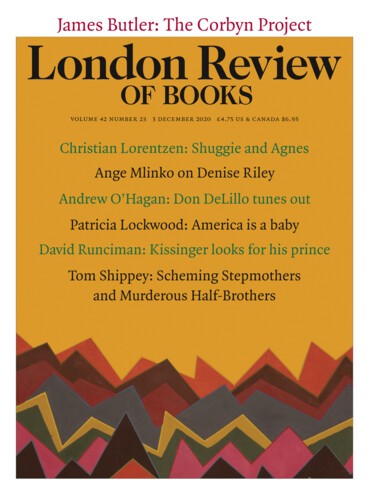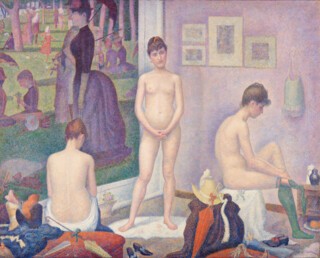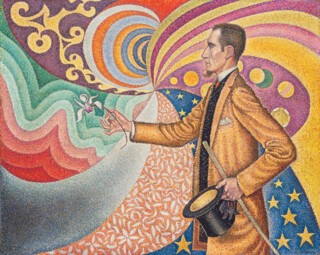Which modern artists identified with anarchism? The Dadaists would be a good guess, but the truly political ones, such as John Heartfield and George Grosz, were communists, and since the early days of Proudhon and Marx anarchists and communists have been more rivals than comrades. The ultra-composed Neo-Impressionists aren’t obvious angels of chaos, yet Georges Seurat, Camille Pissarro, Paul Signac and Maximilien Luce all advocated anarchist positions, including ‘the propaganda of the deed’, aka bomb-throwing. This is one of the riddles of modernist art, and at its centre is the sphinx Félix Fénéon (1861-1944), great champion of Seurat and company, brilliant critic and editor, sophisticated dandy and gallerist – and committed anarchist. An exhibition about his Paris milieu, artistic, literary and political, has reopened at the Museum of Modern Art in New York (until 2 January 2021). It includes many works once held in his vast collection. At his death Fénéon owned 475 paintings and drawings by some fifty European artists and about the same number of objects from Africa and Oceania, which he was among the first in France to acquire. At one point or another he possessed no fewer than 53 paintings and 180 drawings by Seurat alone.
A secret agent in plain view, Fénéon led multiple lives in the 1880s and 1890s. He worked at the War Ministry (of all places), and quickly rose to be its head clerk. At the same time he was also active as an art critic, explicating Neo-Impressionism when it emerged in 1886 (he coined the term); and after Seurat died young in 1891, Fénéon surveyed his studio assiduously, preparing his posthumous reputation. Fénéon cut a dashing figure on the literary scene too, animating several journals, attending Mallarmé’s Symbolist salon and editing Rimbaud’s Illuminations. Amid all this, he also found time for anarchist activities, publishing subversive articles anonymously and pseudonymously, some of which he wrote in workers’ argot. ‘The purpose of all government should be to make government unnecessary,’ he asserted in a definition of anarchism as good as any. ‘The “Fatherland” is just one more entity, an empty, hollow entity, like God, like Society, like the State, like Nature, like Virtue, like Morality, etc.’
Fénéon grew up in the aftermath of the Paris Commune – he turned ten in 1871. Its brutal suppression was an open wound for his generation. (In 1897, as editor of La Revue blanche, he organised a retrospect on the events with statements from participants on both sides, accompanied by ink portraits by Félix Vallotton.) In spite of its downfall but also because of it, the Commune remained a bellwether for anarchists; it was transformative for Marx too. ‘The great social measure of the Commune was its own working existence,’ Marx wrote in Civil War in France (1871), his most anarchisant text; it had demonstrated that ‘the working class cannot simply lay hold of the readymade state machinery, and wield it for its own purposes.’ The finest achievement of the Commune was this autonomy, which made it possible, however briefly, to establish a workers’ council elected by universal suffrage, to abolish both standing army and state police, to provide for free schools independent of the church, and to set up egalitarian forms of ‘mutual aid’ (a term of Kropotkin’s that resonates in the pandemic present). However, the Commune wouldn’t have had the anarchist afterlife it had if the Belle Époque hadn’t been so ugly for the 99 per cent. Forget all the Proustian party pictures; this was a period roiled by extreme inequality, financial scandal, corrupt government, colonial conquest, systemic antisemitism (as evidenced in the Dreyfus Affair), labour strife and police brutality.
In 1892-94 there were eleven bombings in Paris alone. The government passed the ‘villainous laws’ that targeted anarchists directly; after a few bombers were guillotined, others responded with further attacks. On 12 February 1894, Émile Henry, a 21-year-old friend of Fénéon, planted an explosive in Café Terminus at Gare Saint-Lazare, killing one person and injuring twenty. On 4 April another bomb tore up the Restaurant Foyot across from the Senate, and this time Fénéon was a suspect. After the police found several detonators in his office at the War Ministry, Fénéon was put on trial in August. Parrying the judge with his wit, he won over the court. (Judge: ‘It has been established that you surrounded yourself with Cohen and Ortiz,’ two notorious anarchists. Fénéon: ‘One can hardly be surrounded by two persons; you need at least three.’) With Mallarmé as a character witness, he was acquitted by the jury but, naturally, fired from the War Ministry. At this point a benefactor named Thadée Natanson, who had secretly funded his legal defence, stepped in to hire Fénéon as editor of La Revue blanche, where he remained until it closed in 1903, publishing Jarry, Valéry and Apollinaire, as well as Bonnard, Vuillard and Toulouse-Lautrec, among many others.
So how did this anarchist and aesthete reconcile his political and artistic commitments? At the eighth and final Impressionist show in 1886, which included the Seurat masterpiece A Sunday at La Grande Jatte – 1884 (1884-86), Fénéon had an epiphany. Impressionists like Monet had innovated not only in subject matter and approach – ‘modern life directly observed and landscape directly painted’, as Fénéon put it – but also in method: they practised a ‘decomposition of colours’ on the canvas that allowed for their optical recombination at a distance. Yet this was ‘carried out in an arbitrary manner’, whereas Neo-Impressionists like Seurat established a ‘systematic paradigm of this new technique’, which was thereby rectified (this is what the ‘neo’ in Neo-Impressionism meant for Fénéon) according to current theories about the effects of colour and line. Rooted in the studio, Seurat and colleagues had an ‘aversion to the accidental and the transitory’; rather than capturing an ‘impression’ en plein air, they aimed ‘to synthesise the landscape into a definitive aspect which perpetuates the sensation’ by means of ‘pointillist’ touch and ‘divisionist’ colour, and thus to convey ‘nature in its permanent character’, often at the scale of an old Salon tableau. The result, Fénéon concluded, was that ‘the eye is no longer solicited by anything but the essence of the painting.’
What could the rigour of such art have to do with anarchism? Although anarchists seek to overthrow the state, they do so only to claim a more fundamental order. On this point Signac was cheerfully didactic. In The Demolition Worker (1897-99), included in the MoMA show, he brings the stonebreakers of Courbet back not as broken labourers in a barren countryside but as the happy wreckers of an oppressive city: history can and must be restarted. Even more programmatic is his In the Time of Harmony (1893-95), also at MoMA, which offers a near kitsch idyll – a family picnicking, a couple dancing, a painter painting, a man sowing, a woman pruning, men playing boules – as if Signac had condensed the daydream of the young Marx (‘I could fish in the morning, hunt in the afternoon, rear cattle in the evening, and do critical theory at night’) into one scene. Produced in a style that suggests Puvis redone by a folk painter, the subtitle of In the Time of Harmony says it all: ‘The Golden Age Has Not Passed, It Is Still to Come’. Perhaps like most of us, anarchists find it easier to imagine wreckage than utopia. In any case, for Signac the arrangements of painting and society were isomorphic: ‘Justice in sociology, harmony in art: same thing.’ This analogy between a just painting and a just world isn’t as far-fetched as it seems. Subsequent artists with anarchist sympathies, such as Mondrian and Barnett Newman, thought along similar lines – though, fortunately for them, they weren’t trying to depict the golden age.
Also important for the painters advocated by Fénéon was another analogy. While prominent anarchists like Élisée Reclus celebrated ‘the autonomy of the communes’, Fénéon advanced this same value for art, but in a way that many of his comrades couldn’t understand. (‘Not very revolutionary in art, these political revolutionaries,’ he once commented, a sentiment that echoes down the decades.) In the catalogue for the MoMA show, Marnin Young points to a possible connection between the two autonomies. According to Fénéon, Degas painted his nudes crouching in tubs as if their bodies were self-generated. Often posed with their backs towards us and sometimes cropped by the frame, these women also ‘externalise the viewer’, which heightens our sense of autonomy. (Michael Fried would call this ‘absorption’, while Freud might see it as voyeurism.) A related argument can be made about Seurat. In The Models (1886-88), he depicts three nudes in his studio with La Grande Jatte behind them, one on the floor with her back to us, one upright facing us, one seated in profile, and they too appear as if automatically, an effect reinforced by the readymade quality of their classical poses. (Fénéon owned studies of each model, which he cherished so much that he carried them on his person whenever he left Paris.) Sometimes, as in Circus Sideshow (1887-88), Seurat also applies the golden section, which locks the pieces of a picture together, again as though naturally. That a painting should appear to unfold according to its own rules was his supreme fiction. Mondrian and Newman offered other brilliant versions of this aesthetic credo.
Fénéon aimed for an autonomy effect in his writing too. Young tells us that the Symbolist writer Téodor de Wyzewa once complained that Fénéon relied on a ‘grammatical hylozoism’, treating language as if it had a recursive life of its own: ‘He always sees the sky incurving itself, the brushstrokes scattering THEMSELVES, the little boats inverting their own image in the water.’ Like the pictures that Fénéon most admired, his texts aim to be ‘self-governing’ – like communes, we are prompted to think. This autonomy takes nothing away from the singularity of a Seurat painting, a Fénéon text, or an anarchist action: individuality, the sine qua non of anarchism, is not sacrificed – on the contrary. ‘This uniform and almost abstract execution leaves the originality of the artist intact,’ Fénéon wrote of Neo-Impressionist technique, ‘and even heightens it.’ ‘Objective reality’ is but the basis for ‘a superior sublimated reality’ in which ‘personality’ is ‘transfused’. Again, a Mondrian or a Newman appears at once singular and selfless in a similar way. Ditto the prose crafted by Fénéon, which, though often eccentric in its diction and syntax, still seems necessary in its construction. The same is true of his faits divers written for the newspaper Le Matin after 1906. Assembled posthumously as Novels in Three Lines (reviewed by Julian Barnes in the LRB of 4 October 2007), these news snippets relate romantic crimes and other mishaps in such a way that subjective will sometimes turns into objective fate: ‘“If my candidate loses, I will kill myself,” M. Bellavoine, of Fresquienne, Seine-Inférieure, had declared. He killed himself.’ The author of these faits divers comes across as a ‘cruel and sagacious’ god (which is how Fénéon once described Degas), at once dictating the events and removed from them. Jarry dubbed Fénéon ‘celui qui silence’ – ‘he who silences’ – but the line also sounds like ‘celui qui s’y lance’, he who launches into action. Both are apt.
Critics often make tendentious connections between art and politics; getting life and politics to correspond is trickier still. In 1906, Fénéon was hired by the prestigious Galerie Bernheim-Jeune, where he remained, buying and selling as well as curating, until he retired in 1924. Alongside his old friends, Fénéon showed younger artists like Matisse and Modigliani, neither of whom could be accused of anarchism, as well as the first exhibition in Paris of the Futurists, some of whom would later be aligned with fascism. That’s one apparent contradiction, and it is heightened by the fact that, during his art market years, Fénéon gravitated towards the Communist Party. Perhaps out of guilt he once pledged his art collection to the Soviet people, only to think better of it in the end, auctioning it to support his retirement, his wife Fanny and a literary prize named in his honour.
The collection points to another possible contradiction. In the late 1890s, Fénéon opened the pages of La Revue blanche to editorial attacks on colonialism, some of which he wrote anonymously, not only decrying its anti-democratic disregard for self-determination in the abstract, but also singling out particular abuses by military forces in Madagascar and the Transvaal. In the next decades, however, Fénéon began to purchase objects from Africa and Oceania. Some experts believe that he started as early as 1904, which would put him ahead of Matisse and Picasso, whose first acquisitions, epochal for modernist art, were made a few years later; others date his involvement to the First World War. In any case, both the anti-colonial columns and the collecting of tribal art seem to have been informed by his anarchism. ‘Fénéon believed that art, in its power to transform social consciousness, would contribute to the creation of a new world – an Edenic society in which joie de vivre would reign,’ Philippe Peltier writes in the catalogue. ‘Like many of his painter friends, he saw in these remote societies the survival of a creative, balanced world, a distant echo of an ancient Cythera (which he refused to qualify as primitive). And what more than their art could demonstrate the intelligence of people unjustly placed under the colonial yoke?’ Although Fénéon was more enlightened than most contemporaries on this score – he preferred ‘art from remote places’ (arts lointains) to bigoted terms like ‘savage’ – he too indulged in primitivist tropes. And although he insisted on the aesthetic value of tribal objects – in 1920, when they mostly remained in ethnographic museums, he organised a survey on ‘Arts from Remote Places’ with the subtitle ‘Will they be admitted to the Louvre?’ – there was no thought of restitution. Just the opposite, in fact: like other collectors, Fénéon got the goods while the getting was good.
Of course, it’s too much to expect Fénéon to be decolonial avant la lettre. That said, a version of his anarchism has reappeared in art communities. For instance, although Thomas Hirschhorn is as far from Neo-Impressionism as an artist could be, he too insists equally on aesthetic autonomy and political commitment, and much of the agitation against museums today is anarchist in spirit (it is funny-strange that MoMA has now provided a temporary home for old anarchists). More important, anarchism has resurged in political struggles, from the Occupy movement that followed the financial meltdown of 2008 to the mutual aid initiatives that appeared in response to the Covid pandemic and the autonomous zones asserted during the Black Lives Matter uprisings. Nevertheless, for all the fearmongering about antifa (as if to be anti-fascist was a bad thing), anarchism may be another arena where the right has largely muscled out the left. The battle cry of Steve Bannon and gang in 2016, ‘Deconstruct the administrative state,’ is a nasty détournement of the renewed wish of the New Left in the 1960s to smash the government, and certainly the Trump ‘administration’ has done a lot of that demolition. But we should see this for what it is. ‘It was left to the bourgeoisie of the 20th century to incorporate nihilism into its apparatus of domination,’ Benjamin remarked in another time threatened by fascism. Some of our 21st-century rulers, ethnonationalist, neoliberal or both, delight in this same domination through destruction.
Send Letters To:
The Editor
London Review of Books,
28 Little Russell Street
London, WC1A 2HN
letters@lrb.co.uk
Please include name, address, and a telephone number.



